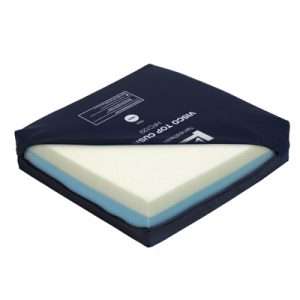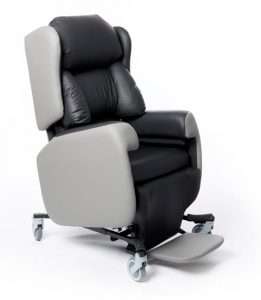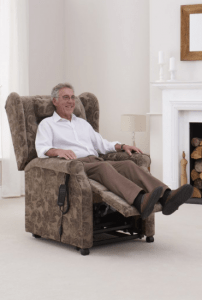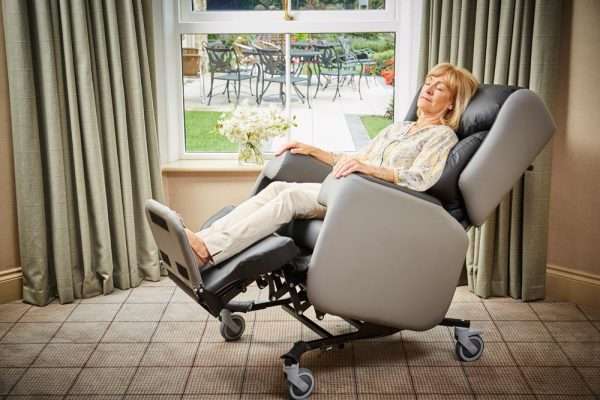Pressure ulcers, commonly known as pressure injuries, pressure sores or bed sores, are sadly very common in bed ridden or immobile people. There are within the NHS each month. Something that often gets overlooked, however, is the risk of pressure ulcers for people who spend long periods of the day sitting.
Often, people think getting someone out of bed and sitting up for a few hours will be enough to prevent pressure sores. But if left unchecked, this can be just as dangerous as being left in bed too long!
Fortunately, pressure ulcers can be prevented by using the correct seating and having good understanding of an individual’s medical conditions. Here are our top tips to maximise pressure care in seating and prevent pressure injuries.
Jump straight to…
‘The Avoidable Epidemic’
Pressure injuries are often referred to as ‘the avoidable epidemic’. They cost the NHS around £5.3 billion each year and result in thousands of preventable hospital admissions.
As the UK tries to recover from the Coronavirus pandemic, reducing the strain on the NHS is more important than ever. Families and healthcare professionals across the country are working to keep people — especially older people — out of hospital where they can.
Pressure injuries are difficult because they can occur very easily in a very short space of time. They can form within 4 hours and are extremely uncomfortable.
Older people are even more susceptible to pressure injuries because their skin is thinner and dryer. This means it deteriorates faster when exposed to pressure and friction.
How can I help?
As pressure sores can develop so quickly, people often feel quite helpless about how best to protect someone. But the right chair will actually help with pressure care rather than hinder it!
Here are four simple ways you can maximise pressure care in seating:
1) Postural Support
Good posture reduces the risk of pressure injuries from sitting.
Typically, good posture is said to be when the head is in line with the hips. However, there will be times where this isn’t possible. So, the key thing to remember is good posture begins at the pelvis.
There are various checks you can do to ensure the pelvis is in the right position, to limit difficulties and discomfort. Check our
Proper support is essential to releasing pressure points throughout the body, especially if someone has postural abnormalities.
For example, if someone has scoliosis and leans to their left, more pressure is applied to the left arm, shoulder, buttock, and thigh. So, you want to redistribute their weight over a larger area. This will avoid isolated pressure build ups and therefore minimise the risk of pressure injury.
You can try a pressure relief cushion with higher support on the affected side. Or, for high risk individuals, you may require a full specialist chair with the backrest and/or lateral supports tailored to their specific needs.

2) Contact with the chair
The more of the body that is in contact with the chair, the less pressure will be exerted in one specific area.
So, maximising the amount of chair-to-body contact helps reduce the chances of pressure injuries. Seat sizing is the most important factor here!
If the chair is too big, the individual may slump onto one side. Too small and the individual may experience friction. There are five key measurements to look at:
- Seat Height
- Seat Depth
- Seat Width
- Armrest Height
- Back Height
Getting any one of these measurements wrong can increase the risk of pressure injuries.
For example, if the seat depth that is too high, the user’s feet won’t be properly supported. Up to 94% of their body weight will then be going through their buttocks and thighs! You can see how that will cause pressure to build up and increase the risk of sores.
If you’re choosing seating for a multi-user environment, it’s best to have a range of chairs that vary in size to cater to different individuals. Or, invest in adjustable chairs which can be resized — like the Lento.
If you’re choosing a chair for an individual, an adjustable chair is also a great option. Or, you should book a seating assessment to ensure your chosen chair is the perfect fit.

Standard backrest with lateral supports
3) Repositioning Options
Regular repositioning is crucial, especially for anyone unable to reposition themselves.
In this case, a carer must help reposition them at least every 2 hours! This will ensure that no areas experience too much pressure at one time.
Tilt-in-space is an excellent feature to look for in a chair. It provides an easy way to reposition a person. Our rise and recline chairs have built-in tilt-in-space, which also maximises body contact with the surface of the chair.
Carers can reposition someone periodically without causing them too much distress or hassle.

4) Cushion Choice
Different cushions meet different needs. Ideally, cushions will incorporate pressure care into their structure to allow better weight distribution and increase the user’s blood flow.
There is not just one cushion that suits everyone. Pressure relief cushions are categorised into three risk bands — low risk, medium risk, and high risk.
A higher risk band means the cushion is designed for someone at higher risk of developing a pressure sore.
Gel, foam and air pressure relief cushions can all be categorised as either low, medium or high risk cushions. It is not the material that determines the risk band, it’s how effectively they relieve pressure.
Alternating air cushions, however, are considered the ‘ultimate’ high-risk cushion. Air is moved from cell to cell inside the cushion, so pressure to builds up in one area before moving onto another area. Unfortunately, users often find them less comfortable. So, it is best to only use them when really necessary.
Is an in-built pressure care cushion best?
In-built pressure care is often available for chairs. They can come with built-in gel pressure relief,
which helps to mould the cushion to the user and provides brilliant pressure redistribution.
Having built-in pressure relief also means that the dimensions of the chair do not change like they would with additional cushions and supports.
However, adding extra cushions and supports allows you to modify the chair over time so it continues to meet the user’s pressure care needs.
Summary
Pressure injuries are not only very painful, but also very common. They have been termed ‘the avoidable epidemic’ because of their high cost to the NHS. This guide shows some simple steps we can all take to help make pressure sores an issue of the past. By choosing a chair that offers: contact with the body; postural support; repositioning options; and the right cushion choice, we can maximise pressure care and prevent pressure ulcers.
Enquire about pressure care seating
If you’re looking for more advice, or want to book a free assessment to find the right chair, please get in touch:
Error: Contact form not found.














